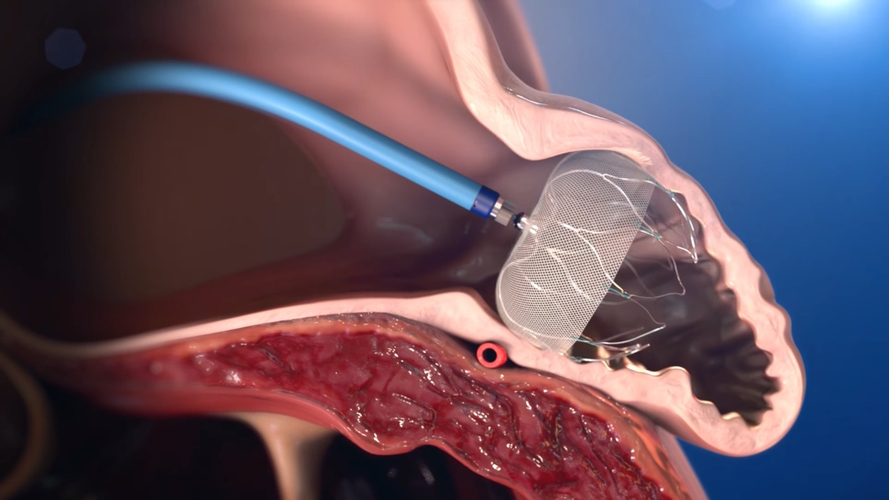Left Atrial Appendage Occlusion (LAAO) | Hong Kong Asia Heart Centre
Atrial fibrillation is the most common heart rhythm disturbance. There are seventy thousand people with AF in the HK.
Atrial fibrillation makes your risk of a stroke five times higher.
When your heart beats normally, its muscle walls squeeze (contract) to force blood out of the heart and around the body.
If you have atrial fibrillation, your heartbeat is irregular and fast, your heart may not have a chance to empty properly before filling up with blood again. Blood can collect inside the upper chamber of the left side of the heart, and this increases the risk of blood clots forming.
If blood clots form in your heart, there is
a risk they can travel in your bloodstream towards your brain. If a clot blocks
one of the arteries leading to your brain, it could cause a stroke. About 90%
of the blood clots that cause stroke are also formed in the left atrial
appendage(LAA). Stroke prevention is the most important part of atrial
fibrillation treatment.
Proccess:
During the process, the patient needs
general anesthesia or monitoring anesthesia, which is done in the cardiac
catheterization laboratory with the help of transesophageal ultrasound and
X-ray fluoroscopy. The cardiologist will insert a catheter into the femoral
vein on the inner thigh of the patient, and implant the occluder into the left
atrial appendage through atrial septal puncture. The occluder is like a
parachute blocking the entrance of the left atrial appendage. After the
parachute opens, it will interact with the heart muscle Connected, like a
natural barrier, to prevent the blood from staying in the clot. After the
operation is completed, the patient can get out of bed on the same day. Normally,
the patient will be hospitalized for about 2 to 3 days.
After Procedure:
- Like other surgeries or treatments, LAA closure surgery also has risks. The doctor will compare the risks of left atrial appendage occlusion and other appropriate treatments with the patient.
- During this period, please continue to take anticoagulant or antiplatelet drugs according to the doctor’s instructions.
- Swimming is not allowed within one week after discharge. Use shower as much as possible for bathing, and keep the wound area clean and dry; avoid lifting heavy objects and avoid excessive strenuous activities within one week.
Atrial fibrillation is the most common heart rhythm disturbance. There are seventy thousand people with AF in the HK.
Atrial fibrillation makes your risk of a stroke five times higher.
When your heart beats normally, its muscle walls squeeze (contract) to force blood out of the heart and around the body.
If you have atrial fibrillation, your heartbeat is irregular and fast, your heart may not have a chance to empty properly before filling up with blood again. Blood can collect inside the upper chamber of the left side of the heart, and this increases the risk of blood clots forming.
If blood clots form in your heart, there is
a risk they can travel in your bloodstream towards your brain. If a clot blocks
one of the arteries leading to your brain, it could cause a stroke. About 90%
of the blood clots that cause stroke are also formed in the left atrial
appendage(LAA). Stroke prevention is the most important part of atrial
fibrillation treatment.
Proccess:
During the process, the patient needs
general anesthesia or monitoring anesthesia, which is done in the cardiac
catheterization laboratory with the help of transesophageal ultrasound and
X-ray fluoroscopy. The cardiologist will insert a catheter into the femoral
vein on the inner thigh of the patient, and implant the occluder into the left
atrial appendage through atrial septal puncture. The occluder is like a
parachute blocking the entrance of the left atrial appendage. After the
parachute opens, it will interact with the heart muscle Connected, like a
natural barrier, to prevent the blood from staying in the clot. After the
operation is completed, the patient can get out of bed on the same day. Normally,
the patient will be hospitalized for about 2 to 3 days.
After Procedure:
- Like other surgeries or treatments, LAA closure surgery also has risks. The doctor will compare the risks of left atrial appendage occlusion and other appropriate treatments with the patient.
- During this period, please continue to take anticoagulant or antiplatelet drugs according to the doctor’s instructions.
- Swimming is not allowed within one week after discharge. Use shower as much as possible for bathing, and keep the wound area clean and dry; avoid lifting heavy objects and avoid excessive strenuous activities within one week.


